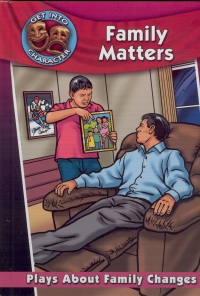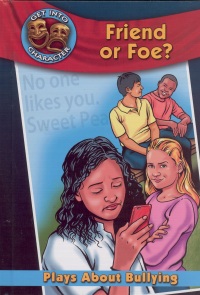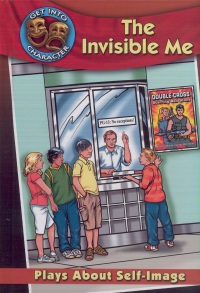| ________________
CM . . .
. Volume XVI Number 35. . . .May 14, 2010 
 |
Where Do I Belong? Plays About Fitting In. (Get Into Character).
Catherine Gourley.
St. Catharines, ON: Crabtree, 2010.
32 pp., pbk. & hc., $9.95 (pbk.), $20.76 (RLB.).
ISBN 978-0-7787-7380-1 (pbk.), ISBN 978-0-7787-7366-5 (RLB.).
Subject Headings:
Self-acceptance-Juvenile drama.
Social acceptance-Juvenile drama.
Children's plays, American.
Grades 3-6 / Ages 8-11.
Review by Jocelyn A Dimm.
* /4
|
| |
|
 |
Flashpoints! Plays About Controlling Anger. (Get Into Character).
Catherine Gourley.
St. Catharines, ON: Crabtree, 2010.
32 pp., pbk. & hc., $9.95 (pbk.), $20.76 (RLB.).
ISBN 978-0-7787-7376-4 (pbk.), ISBN 978-0-7787-7362-7 (RLB.).
Subject Headings:
Anger-Juvenile drama.
Children's plays, American.
Grades 3-6 / Ages 8-11.
Review by Jocelyn A Dimm.
* /4
|
| |
|
 |
What's the Difference? Plays About Tolerance. (Get Into Character).
Catherine Gourley.
St. Catharines, ON: Crabtree, 2010.
32 pp., pbk. & hc., $9.95 (pbk.), $20.76 (RLB.).
ISBN 978-0-7787-7378-8 (pbk.), ISBN 978-0-7787-7364-1 (RLB.).
Subject Headings:
Toleration-Juvenile drama.
Children's plays, American.
Grades 3-6 / Ages 8-11.
Review by Jocelyn A Dimm.
* /4
|
| |
|
 |
Family Matters: Plays About Family Changes. (Get Into Character).
Catherine Gourley.
St. Catharines, ON: Crabtree, 2010.
32 pp., pbk. & hc., $9.95 (pbk.), $20.76 (RLB.).
ISBN 978-0-7787-7375-7 (pbk.), ISBN 978-0-7787-7361-0 (RLB.).
Subject Headings:
Separation anxiety-Juvenile drama.
Divorce-Juvenile drama.
Pet loss-Juvenile drama.
Children's plays, American.
Grades 3-6 / Ages 8-11.
Review by Jocelyn A Dimm.
* /4
|
| |
|
 |
Friend or Foe? Plays About Bullying. (Get Into Character).
Catherine Gourley.
St. Catharines, ON: Crabtree, 2010.
32 pp., pbk. & hc., $9.95 (pbk.), $20.76 (RLB.).
ISBN 978-0-7787-7377-1 (pbk.), ISBN 978-0-7787-7363-4 (RLB.).
Subject Headings:
Bullying-Juvenile drama.
Children's plays, American.
Grades 3-6 / Ages 8-11.
Review by Jocelyn A Dimm.
* /4
|
| |
|
 |
The Invisible Me: Plays About Self-Image. (Get Into Character).
Catherine Gourley.
St. Catharines, ON: Crabtree, 2010.
32 pp., pbk. & hc., $9.95 (pbk.), $20.76 (RLB.).
ISBN 978-0-7787-7379-5 (pbk.), ISBN 978-0-7787-7365-8 (RLB.).
Subject Headings:
Body image-Juvenile drama.
Children's plays, American.
Grades 3-6 / Ages 8-11.
Review by Jocelyn A Dimm.
* /4
|
| |
|

excerpt:
Olivia: There was a mix-up with the music. That wasn't Rachel's music. It was mine. If it's okay, I'd like to give up my spot so that Rachel can have her chance.
Narrator 1: Olivia walks off stage. She goes to the stage manager and tells her to put Rachel's original CD on. Then she goes up to Rachel and gives her a hug.
Olivia: Go ahead Rachel. You know you can do this!
Narrator 2: A moment later, Rachel walks on to the stage again. The audience applauds warmly.
Narrator 3: Rachel puts on a beautiful performance. When she takes her final bow, she is smiling widely.
Narrator 1: Rachel does not win. Olivia has been eliminated. Even so, they hug each other backstage. Rachel's brother comes backstage to congratulate her.
In this Readers Theatre style series of six books, there are two scripts to each book. Each book (and the two scripts inside) deals with a specific issue or theme.
Where Do I Belong? offers two plays about fitting in: a) "On the Fringe" is about a ninth grade student and bass player who finds out he is also talented at football, and b) "The Dancers" is about a dance competition between two girls in the seventh grade.
Flashpoints! has two plays about controlling anger: a) "Striker" has an injured seventh grade soccer player yelling at his team mates from the bench, and b) "Home Rules," a 12-year-old girl who yells at people to get her way.
What's the Difference? contains two plays about tolerance: a) "Who's Got Game? tells of seventh grade girls who play basketball in summer camp with some unhealthy egos, and b) "Breaking News" has teenagers dealing with racial slurs.
Family Matters gives plays about family change: a) "The Day my Dad Left" has an eighth grade boy dealing with his parents' divorce, and b) "No Pets Allowed" tells of a seventh grader having to move and being told her dog has to stay and can't come.
Friend or Foe? offers plays about bullying: a) "The Newbie" has a seventh grade girl as a victim of cyber bullying, and b) "The Secret Life of a Bully" shows a teenage bully who is bullied by his father at home.
The Invisible Me has plays about self image: a) "Small Man Sam" is a vertically challenged eighth grader, and b) "Purr-fect" tells of an eighth grade girl who is verging on anorexic behaviour.
I have no doubt that the intent of the author, the project co-ordinators, and the publishers of this series was in the appropriate place. The issues presented in these six Readers Theatre style plays/books are valid and important ones in the world of children, youth and young adults. However, as a drama educator who has had experience over the last 25 years teaching drama education at primary, secondary, and post-secondary levels, the first questions that came to mind were: Why wasn't this series written by a collection of authors that included drama education experts? Why are the illustrations flat stereotyped computer images? Why are educational materials still being offered in recipe style formats that ask educators to believe these methods are worthwhile ways of tackling sensitive issues with students?
Although these comments may sound harsh, if one spends a few hours on the web researching children's, youth, and YA (young adult) novels and picture books, graphic novels, student-created web pages, zines, and practice-based literacy/drama educational materials (such as the texts of Dr. David Booth, University of Toronto) that are readily available, then I believe these comments offer resounding validity.
The series, entitled "Get into Character," tries to do everything "right" – the right amount of sensitive issues, the right amount of multi-character, socio-cultural scenarios, and the right amount of positive outcomes through positive adult influences. In fact, the ability to "fix-a-problem" in a seven or eight page script is overwhelmingly idealistic to the point of unrealistic context. Every one of the 12 short plays has a positive ending. For example, in a dancing competition (excerpt above), one of the competitors gives up her place for another dancer and, although neither one of them wins, both of them remain happy. How real is this scene to students who live in the age of American Idol?
It seems the graphics were intended to appeal to students; however, after seeing some of the amazing artwork of illustrators such as David Diaz, Gene Luen Yang, and Shaun Tan, the images of the "Get into Character" series have serious flaws. In these computer generated images, not one character is overly heavy or overly thin, and not one character has a skin-problem. An attempt is made to show sociocultural diversity through images such as a character in a wheelchair and a female police officer; however, their presence seems to signify political correctness rather than genuine purpose. As illustrated and supported by the text, no family seems to live below the poverty line, no story is without at least one all-knowing adult, and no elderly people exist at all. There are no signs in any of the family dwellings of any cultural heritage whatsoever.
What the texts neglect to do that is vitally important for children in grades 3-6 (at whom this series is inappropriately directed) is allow the children to use their imaginations. Students are quite capable of writing their own imaginative Readers Theatre scripts about issues that are meaningful to them. If portions of the plays could have possibly been offered as starter scenes that students were engaged in finishing or offered as ideas students could turn into their own scripts, the project would have acknowledged the creative power of student-centered learning.
This series was taken into a drama education class where university students are training to become elementary school teachers. After two days working in groups of six, each group analyzing a book, the class came together as a whole sharing their findings. The following are the groups' summaries:
RECOMMENDATIONS
"Get Into Character" series
Students write their own scripts; their own stories
Possibly one set for the library as a reference
Be sensitive to local issues and context
Don't teach life skills in isolation or through "programs"
For Grade 6+
Canadian series available?
SUGGESTIONS
Students create own materials
Drama workshops
Digital copy that can be adapted
Incorporate drama into everyday curriculum
One redeeming quality of the series is the "Think It Over" section at the end of every play. The questions are open-ended and intended to engage the students in a constructive, reflective dialogue. Unfortunately, these sections just aren't strong enough.
Not recommended.
Jocelyn A. Dimm is a sessional instructor and doctoral candidate at the University of Victoria where she teaches drama education and young adult literature in the Faculty of Education.

To comment
on this title or this review, send mail to cm@umanitoba.ca.
Copyright © the Manitoba Library Association. Reproduction for personal
use is permitted only if this copyright notice is maintained. Any
other reproduction is prohibited without permission.
NEXT REVIEW |
TABLE OF CONTENTS FOR THIS ISSUE
- May 14, 2010.
AUTHORS |
TITLES |
MEDIA REVIEWS |
PROFILES |
BACK ISSUES |
SEARCH |
CMARCHIVE |
HOME |





